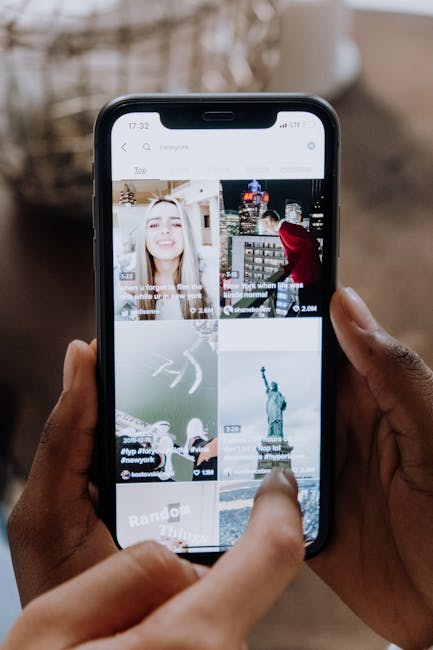Video Killed The Radio Star: Why Video Ads Dominate Social Media
The year 1979 saw the release of The Buggles’ iconic single, “Video Killed The Radio Star,” a prophetic lament about the impending shift in media consumption as television, and specifically music videos, began to eclipse the golden age of radio. This cultural touchstone, often cited as the first music video ever aired on MTV in 1981, perfectly encapsulated a paradigm shift: visual storytelling was asserting its dominance over auditory experiences. Fast forward to the present day, and this analogy finds an uncanny resonance in the digital advertising landscape. In the realm of social media, video content has not merely joined the ranks of effective advertising formats; it has, in a metaphorical sense, “killed the radio star” of static images and text-heavy posts, establishing itself as the undisputed king of engagement and conversion. The pervasive nature of smartphones, coupled with ever-improving internet speeds, has transformed social platforms into video-first environments, making video ads an indispensable cornerstone of any successful digital marketing strategy.
The shift towards video is not a fleeting trend but a fundamental recalibration of how audiences consume information and interact with brands. This evolution is deeply rooted in human psychology and technological advancements. Our brains are wired to process visual information far more efficiently than text. A staggering percentage of sensory receptors are dedicated to vision, allowing us to absorb complex ideas and emotional nuances almost instantaneously when presented visually. When motion and sound are added, the cognitive load is further reduced, and the potential for emotional connection skyrockles. This innate human preference for dynamic, multi-sensory experiences is precisely why video ads cut through the noise on cluttered social feeds. A static image might get a glance, but a well-crafted video has the power to stop the scroll, captivate attention, and convey a narrative in a way that text and images alone simply cannot. The anecdotal evidence is overwhelming, and the data unequivocally supports this assertion: video content consistently outperforms other formats in terms of reach, engagement, and ultimately, return on investment for advertisers.
The Proliferation of Video Consumption and Mobile Dominance
The sheer volume of video content consumed daily is staggering and continues to grow exponentially. Billions of hours of video are watched globally every day, with a significant portion of this consumption occurring on mobile devices. This mobile-first paradigm is a critical factor in video’s dominance on social media. Smartphones, equipped with high-resolution screens and increasingly sophisticated cameras, have become personal entertainment hubs, news sources, and communication tools. Users expect a seamless, engaging visual experience on their handheld devices, and video delivers precisely that. The convenience of watching short-form videos on the go – whether commuting, waiting in line, or simply during downtime – has ingrained video consumption deeply into daily routines.
Platforms like TikTok have masterfully capitalized on this mobile-first, short-form video trend, building an empire almost entirely on user-generated, highly engaging video content. Its explosive growth forced other established platforms, including Instagram and Facebook, to pivot rapidly, introducing features like Reels to compete for dwindling attention spans. YouTube, the original behemoth of online video, has also embraced short-form content with YouTube Shorts, acknowledging the shift in consumer preferences. This widespread adoption by platforms underscores a fundamental truth: if advertisers want to reach audiences where they are, they must embrace video. The average user spends hours each day scrolling through social media feeds, and a significant portion of that time is dedicated to watching videos. Brands that fail to integrate video into their social media advertising strategies risk becoming invisible in an increasingly visual digital landscape. The sheer accessibility of video creation tools, from sophisticated editing software to simple smartphone apps, has democratized content production, allowing even small businesses to produce compelling video ads without exorbitant budgets. This accessibility further fuels the video content boom, creating a virtuous cycle where more video content leads to higher user expectations, which in turn drives more video production.
Psychological Underpinnings: Why Video Resonates
The efficacy of video ads on social media extends beyond mere accessibility and consumption habits; it is deeply rooted in cognitive and emotional psychology. Understanding these psychological principles is key to crafting truly impactful video campaigns.
Firstly, visual superiority: The human brain processes visual information thousands of times faster than text. When presented with a video, we immediately grasp context, identify objects, and interpret expressions without conscious effort. This rapid processing means that video can convey complex messages and evoke specific emotions far more efficiently than static images or written copy. A product demonstration video, for example, can show features in action, illustrate benefits, and address potential concerns in seconds, a task that would require paragraphs of descriptive text.
Secondly, emotional connection and empathy: Video, with its combination of visuals, sound, music, and often human subjects, is unparalleled in its ability to evoke emotion. Laughter, excitement, sadness, inspiration – these feelings are potent drivers of engagement and memorability. Brands can leverage storytelling through video to create narratives that resonate deeply with viewers, forging an emotional bond that transcends a simple transactional relationship. Seeing real people use a product, sharing their experiences, or hearing testimonials in their own voices builds empathy and trust in a way that written reviews often cannot. This emotional resonance is critical in building brand loyalty and fostering a sense of connection with the audience.
Thirdly, narrative power: Humans are inherently wired for stories. Since ancient times, stories have been our primary means of transmitting knowledge, values, and culture. Video is the ultimate storytelling medium in the digital age. A well-constructed video ad can take viewers on a journey, present a problem and offer a solution, or introduce them to a brand’s ethos and values. This narrative structure keeps viewers engaged, as they become invested in the unfolding story, creating a more immersive and memorable experience than a traditional advertisement. Storytelling in video ads is not about selling a product directly; it’s about selling an experience, a lifestyle, or a solution, making the consumer feel understood and valued.
Fourthly, building trust and authenticity: In an era of digital skepticism, authenticity is a prized commodity. Video ads, particularly those that feel raw, unpolished, or feature user-generated content, can foster a sense of genuine trust. Seeing is believing, and video offers a more transparent view of a product, service, or brand’s personality than highly Photoshopped images or carefully crafted text. Live video, in particular, offers an unfiltered glimpse, showcasing authenticity and allowing for real-time interaction, further solidifying trust. This perceived authenticity helps bridge the gap between brand and consumer, making the brand feel more relatable and human.
Lastly, parasocial relationships: Video content, especially from influencers or brand representatives who frequently appear on camera, can foster parasocial relationships. Viewers develop a sense of familiarity, trust, and even affection for these personalities, much like they would for a celebrity or a friend. This phenomenon is incredibly powerful for advertisers, as recommendations from trusted, albeit virtually known, individuals carry significant weight. Influencer marketing, predominantly video-based, leverages these parasocial bonds to drive purchasing decisions.
Technical Advantages and Algorithmic Preference
Beyond the psychological impact, video ads possess several technical and practical advantages that contribute to their dominance on social media. These advantages are often amplified by the very algorithms that govern content distribution on these platforms.
Higher Engagement Rates: Data consistently shows that video content generates significantly higher engagement rates compared to static images or text posts. This includes higher click-through rates (CTRs), more likes, shares, and comments. Shares are particularly valuable, as they extend organic reach and introduce the brand to new audiences without additional ad spend. The dynamic nature of video compels viewers to stop scrolling, watch, and often interact, whereas static content is more easily scrolled past in a busy feed.
Better Recall and Brand Recognition: The multi-sensory nature of video leads to superior information retention. Viewers are more likely to remember a brand, its message, and its call to action when presented in a video format. This enhanced recall translates directly into stronger brand recognition and top-of-mind awareness when consumers are making purchasing decisions. A memorable jingle, a striking visual, or an engaging narrative embedded in a video ad can stick with a viewer long after they have scrolled past.
Conveying Complex Information: Some products or services are inherently complex and difficult to explain through static visuals or text. Video excels at breaking down intricate concepts, demonstrating product functionality, or illustrating step-by-step processes. From software tutorials to assembly instructions for furniture, video provides a clear, concise, and easy-to-follow explanation that static media cannot replicate. This ability to simplify complex information enhances the user experience and reduces friction in the customer journey.
Sound and Motion Capture Attention: In a feed saturated with content, the introduction of motion and sound is an immediate attention grabber. While many users watch videos without sound initially, the motion itself is often enough to stop the scroll. For those who enable sound, the audio layer adds another dimension, reinforcing the message, setting a mood, or providing crucial context. Effective video ads are designed to work both with and without sound, ensuring maximum impact regardless of the user’s viewing environment.
Algorithmic Preference: Social media platforms are fundamentally driven by algorithms designed to maximize user engagement and time spent on the platform. Since video content typically garners higher engagement, algorithms are increasingly programmed to prioritize its distribution. This means that video ads often receive greater organic reach and more favorable ad placement compared to other formats. Platforms want to keep users entertained and engaged, and currently, video is their most potent tool for achieving this. By favoring video, platforms incentivize advertisers to create more video content, further cementing its dominant position. This algorithmic push creates a self-reinforcing cycle where brands that adopt video strategies are rewarded with greater visibility, driving even more brands to invest in video advertising.
Social Media Platform Strategies: The Video Imperative
Every major social media platform has either been built on video or has aggressively pivoted to prioritize it, acknowledging its undeniable power in capturing and retaining user attention. This platform-level commitment to video underscores its absolute necessity for advertisers.
TikTok: The quintessential video-first platform, TikTok’s explosive growth redefined social media consumption. Its algorithm is incredibly adept at serving hyper-personalized short-form video content, leading to unprecedented levels of engagement and virality. For advertisers, TikTok offers a unique opportunity to tap into trends, leverage user-generated content (UGC) styles, and reach a younger, highly engaged demographic. Ads on TikTok often thrive when they blend seamlessly with organic content, feeling authentic and entertaining rather than overtly promotional. This “native advertising” approach is a cornerstone of TikTok’s advertising success.
Facebook and Instagram (Meta Platforms): Once dominated by photos and text, Meta platforms have undergone a massive transformation, placing Reels (short-form video) at the forefront of their strategy. Instagram’s entire interface has been redesigned to highlight Reels, and Facebook continues to push video in feeds and Stories. This shift was a direct response to TikTok’s rise and reflects Meta’s understanding that video is essential for future growth and user retention. Advertisers on these platforms must now prioritize video campaigns, leveraging Reels ads, in-stream video ads, and Story ads to effectively reach their vast user bases. Meta’s robust targeting capabilities combined with video’s engaging nature make for a powerful advertising combination.
YouTube: As the original online video giant, YouTube continues to be a crucial platform for long-form video content and an increasingly important player in short-form with YouTube Shorts. Beyond pre-roll and in-stream ads, YouTube offers unique opportunities for brand integration with creators, sponsorships, and direct response campaigns. Its strength lies in its ability to cater to both passive entertainment and active information seeking, making it ideal for everything from detailed product reviews to brand storytelling. The platform’s massive audience and deep analytics provide advertisers with unparalleled insights into video performance.
X (formerly Twitter): While historically more text-centric, X has steadily increased its support for video content, from live streaming events to in-feed video ads. Videos on X tend to be concise, timely, and often used for breaking news, announcements, or short, impactful messages. Brands use video on X to engage in real-time conversations, launch campaigns, and share dynamic content that cuts through the rapid-fire text stream. Live video is particularly powerful for events, Q&As, and product launches, offering a direct, unfiltered connection with the audience.
LinkedIn: Even the professional networking site, LinkedIn, has embraced video, recognizing its power for thought leadership, professional branding, and B2B marketing. Video resumes, company culture videos, explainer videos for complex services, and CEO messages are now common. LinkedIn Video Ads allow businesses to reach a highly targeted professional audience with engaging content, fostering trust and demonstrating expertise. Video on LinkedIn helps establish credibility and build relationships in a professional context.
Pinterest: Known initially as a visual discovery engine for static images, Pinterest has also integrated video content, particularly with Idea Pins. Video on Pinterest allows creators and brands to provide more context, demonstrate products, and inspire users with dynamic content. Shoppable video pins are a natural fit for Pinterest’s commerce-driven user base, enabling seamless transitions from inspiration to purchase.
This universal embrace of video across diverse social media platforms is not coincidental; it is a strategic response to evolving consumer behavior and the undeniable effectiveness of video as an advertising medium. Brands that align their strategies with these platform imperatives will be the ones that thrive.
Dominant Types of Video Ads on Social Media
The versatility of video allows for a myriad of ad formats, each suited for different objectives and audience segments. Understanding the most effective types is crucial for optimizing campaigns.
Short-Form Video Ads: These are the undisputed champions of attention in the current social media landscape, typically ranging from 15 to 60 seconds, with 15-30 seconds being optimal for platforms like TikTok and Reels. Their conciseness forces advertisers to be incredibly creative and impactful from the very first second. They are designed for quick consumption, immediate impact, and high virality, perfect for driving brand awareness and rapid engagement.
User-Generated Content (UGC) Style Ads: These ads mimic the look and feel of organic, unpolished content created by everyday users. They often feature real people, authentic reactions, and a less “produced” aesthetic, making them highly relatable and trustworthy. UGC-style ads are incredibly effective because they don’t feel like traditional advertisements; they feel like genuine recommendations from peers, bypassing ad skepticism. Testimonials, product reviews, and “day in the life” content fall into this category.
Testimonial and Review Videos: Building on the power of UGC, dedicated testimonial videos feature satisfied customers sharing their positive experiences with a product or service. Seeing and hearing genuine enthusiasm from real users provides powerful social proof and builds immediate credibility. These are particularly effective for conversion-focused campaigns.
How-To and Tutorial Videos: For products or services that require explanation, how-to or tutorial videos are invaluable. They demonstrate the functionality, benefits, and ease of use in a clear, concise manner. These videos are highly engaging for problem-solving audiences and can significantly reduce customer support inquiries while boosting conversions by showcasing a product’s value proposition.
Explainer Videos: Similar to tutorials but often more animated or graphically driven, explainer videos simplify complex concepts, products, or services into easily digestible visual narratives. They are excellent for new product launches, introducing innovative technologies, or clarifying service offerings, making abstract ideas concrete and understandable.
Brand Storytelling Videos: These videos focus less on direct selling and more on conveying a brand’s values, mission, or origin story. They aim to build an emotional connection with the audience, fostering brand loyalty and affinity. They often evoke powerful emotions and humanize the brand, creating a deeper relationship with consumers.
Live Shopping and Streamed Events: The integration of live video with e-commerce, popularized in Asia, is gaining significant traction globally. Live shopping events allow brands to showcase products, answer questions in real-time, and offer exclusive deals, creating an interactive and immersive shopping experience. Similarly, live streamed events like product launches, Q&As with experts, or behind-the-scenes tours offer unparalleled authenticity and direct audience engagement.
Interactive Video Ads: While still evolving, interactive video ads allow viewers to actively engage with the content – clicking on hotspots, answering polls, choosing their adventure, or personalizing aspects of the ad. This level of interaction enhances engagement, provides valuable data, and creates a more memorable, personalized experience.
Key Elements of Effective Social Media Video Ads
Creating a video ad is one thing; creating an effective one that cuts through the noise and drives results is another. Several critical elements contribute to a video ad’s success on social media.
The Hook in the First 3 Seconds: Social media feeds are fast-paced, and attention spans are fleeting. The first 3-5 seconds of your video ad are absolutely crucial. This is your only chance to grab the viewer’s attention and compel them to keep watching. This “hook” could be a surprising visual, an intriguing question, a dramatic statement, or a quick demonstration of a desirable outcome. Without a strong hook, your ad will be scrolled past before its message even begins.
Clear Call to Action (CTA): Every effective ad, especially video, must have a clear, concise, and compelling call to action. What do you want the viewer to do next? “Shop Now,” “Learn More,” “Sign Up,” “Download App,” “Visit Website” – ensure your CTA is prominently displayed, verbally stated, and ideally integrated into the video’s narrative. A strong CTA removes ambiguity and guides the viewer towards the desired conversion.
Mobile Optimization (Vertical Video, Captions): Since the vast majority of social media consumption occurs on mobile devices, video ads must be optimized for mobile viewing. This means prioritizing vertical video formats (9:16 aspect ratio) for Stories and Reels, which fill the screen and provide an immersive experience. Crucially, given that many users watch videos without sound initially, captions are non-negotiable. Text overlays and clear visuals should convey the core message even with the sound off.
Sound On/Sound Off Considerations: Design your video to be effective both with and without sound. While sound adds an important layer, many users watch silently. Use strong visuals, clear text overlays, and compelling body language to convey your message. Then, use sound and music to enhance the experience for those who choose to listen, adding emotional depth and professional polish.
Authenticity Over Perfection: In the age of user-generated content, overly polished, highly produced ads can sometimes feel less genuine. Social media users often respond better to authenticity, even if it means a slightly rougher aesthetic. Don’t be afraid to embrace a more human, relatable, and less corporate feel, especially for short-form, rapid-fire content. This aligns with the organic nature of social feeds and builds trust.
Storytelling: As previously discussed, narrative power is key. Frame your ad as a mini-story with a beginning, middle, and end. Introduce a problem, present your product as the solution, and showcase the positive outcome. Even in 15 seconds, a compelling story can be told.
Humor and Emotion: Leveraging humor or strong emotions (joy, inspiration, curiosity) can make your ad highly memorable and shareable. Emotional ads resonate deeply and are more likely to be retained in the viewer’s memory, leading to stronger brand recall and affinity.
Personalization: Where possible, leverage targeting capabilities to personalize your video ads. Showing a product relevant to a user’s browsing history or demographic, or even addressing them indirectly through segment-specific messaging, can significantly increase relevance and engagement.
A/B Testing: Continuously test different versions of your video ads (different hooks, CTAs, lengths, visuals, music) to identify what resonates best with your target audience. Data-driven optimization is crucial for maximizing ROI. Small tweaks based on performance insights can lead to significant improvements in campaign effectiveness.
Measurement and ROI of Video Ads
The dominance of video ads on social media is not just about anecdotal success or perceived engagement; it’s backed by robust analytics and measurable return on investment (ROI). Advertisers can track a wide array of metrics to gauge performance and optimize campaigns.
Key Metrics for Video Ads:
- View-Through Rate (VTR) and Completion Rate: VTR measures the percentage of impressions that result in a view (often defined as 3 seconds or more). Completion rate tracks how much of the video viewers watched (e.g., 25%, 50%, 75%, 100%). High completion rates indicate an engaging video that resonates with the audience, while low rates suggest a need to re-evaluate the content or hook.
- Engagement Rate: This encompasses likes, comments, shares, and saves. Shares are particularly valuable as they extend organic reach. High engagement signals strong audience connection and can boost algorithmic favorability.
- Click-Through Rate (CTR): Measures the percentage of viewers who click on the ad’s call to action. A high CTR indicates that the video successfully piqued interest and compelled action.
- Conversion Rate: The ultimate metric, tracking the percentage of clicks that lead to a desired action, such as a purchase, lead submission, or app download. This directly links video ad spend to business outcomes.
- Cost Per View (CPV): The average cost an advertiser pays for each view of their video ad. Lower CPV indicates more efficient ad spend.
- Reach and Impressions: How many unique users saw the ad (reach) and the total number of times the ad was displayed (impressions). These metrics indicate the scale of the campaign.
- Brand Lift Metrics: For awareness campaigns, marketers often look at brand lift studies, which measure changes in brand recall, ad recall, brand favorability, and purchase intent among exposed vs. control groups.
Attribution Modeling for Video:
While direct conversion metrics are vital, understanding the full impact of video ads often requires sophisticated attribution modeling. Video ads frequently play a significant role in the customer journey, even if they aren’t the final click that leads to a conversion. They can build awareness, generate interest, and nurture leads further down the funnel. Multi-touch attribution models help marketers understand the contribution of video at various stages of the conversion path, ensuring proper credit is given beyond last-click attribution. This holistic view demonstrates the broader value of video beyond immediate conversions, justifying continued investment.
Advanced Analytics and AI in Video Advertising:
The evolution of advertising technology provides increasingly sophisticated tools for analyzing video performance. AI-powered analytics can identify which elements of a video ad are most engaging (e.g., specific scenes, facial expressions, sound cues) and predict audience response. This allows for hyper-optimization, even dynamically adjusting ad creatives in real-time based on performance. AI can also assist in audience segmentation and predictive targeting, ensuring video ads reach the most receptive viewers. Furthermore, programmatic advertising platforms leverage AI to bid on ad placements and optimize delivery for video campaigns, maximizing efficiency and ROI. The ability to collect granular data on video consumption behavior provides invaluable insights for refining future creative strategies and audience targeting. This continuous feedback loop of data collection, analysis, and optimization is a key driver of video advertising’s effectiveness.
Challenges and Future Trends in Video Advertising
Despite its current dominance, the landscape of social media video advertising is not without its challenges, and it is constantly evolving. Staying ahead requires anticipating future trends and adapting strategies accordingly.
Content Saturation and Ad Fatigue: The sheer volume of video content means that feeds are increasingly saturated. This can lead to ad fatigue, where users become desensitized to ads or actively seek to avoid them. The challenge for advertisers is to continuously create fresh, engaging, and non-intrusive content that breaks through the clutter without becoming annoying. Quality, relevance, and entertainment value become paramount.
Production Costs (Mitigated by UGC): While accessible tools have democratized video creation, high-quality, professional video production can still be expensive and time-consuming. However, the rise of user-generated content (UGC) and authentic, less polished styles helps mitigate this. Brands are increasingly leveraging influencers and their own customers to create compelling video content at a lower cost, which also tends to perform better due to its authenticity. The emphasis shifts from Hollywood-level production to genuine connection.
Privacy Concerns and Data Restrictions: Increasing privacy regulations (like GDPR and CCPA) and platform changes (like Apple’s App Tracking Transparency) are making it more challenging to track users and deliver hyper-targeted ads. Advertisers must adapt by focusing on first-party data, contextual targeting, and creating broader, yet still highly engaging, content that appeals to larger segments. The reliance on broad behavioral data might decrease, pushing brands to rely more on creative excellence.
The Rise of AI-Generated Video: Artificial intelligence is rapidly advancing in its ability to generate realistic video content, from synthetic voices and realistic avatars to entire scenes. This technology has the potential to dramatically reduce production costs and allow for unprecedented levels of personalization and scalability. Brands could soon generate hundreds of variations of an ad, each tailored to specific user segments, with AI automatically optimizing for performance. This opens up new frontiers for dynamic creative optimization and hyper-personalized ad experiences.
Metaverse, VR, and AR Integration: The future of social media is likely to involve more immersive experiences within the metaverse, incorporating virtual reality (VR) and augmented reality (AR). Video advertising will evolve to become more interactive and experiential within these new environments. Imagine AR filters that allow users to virtually try on products, or VR experiences that transport them into a brand’s world. Shoppable 3D video experiences will become commonplace, blurring the lines between content, commerce, and entertainment.
Shoppable Video: The seamless integration of e-commerce within video content is a rapidly growing trend. Shoppable video allows viewers to click directly on products within a video ad to learn more or make a purchase without leaving the platform. This reduces friction in the customer journey and significantly shortens the path to conversion, transforming video from a mere awareness tool into a powerful direct sales channel. Live shopping events are a prime example of this trend.
Hyper-Personalization and Dynamic Creative Optimization: Leveraging advanced data analytics and AI, video ads will become even more personalized. Dynamic creative optimization (DCO) allows advertisers to automatically generate different versions of an ad in real-time, tailoring elements like visuals, text overlays, and calls to action based on individual user data, context, and predicted preferences. This ensures that each viewer sees the most relevant and compelling version of the ad, maximizing engagement and conversion rates. This level of personalization will make video ads feel less like mass marketing and more like bespoke recommendations.
The narrative of “Video Killed The Radio Star” serves as a potent reminder that media landscapes are constantly shifting. Just as music television reshaped the music industry, video advertising has fundamentally transformed how brands connect with consumers on social media. Its dominance is not accidental but a result of its inherent psychological appeal, technical advantages, algorithmic favor, and the universal shift towards mobile-first, visual consumption. As technology continues to evolve and user expectations for engaging content grow, video will remain at the forefront of social media advertising, pushing the boundaries of creativity, personalization, and interactive engagement. The future of digital marketing is undeniably visual, dynamic, and undeniably video-centric.











